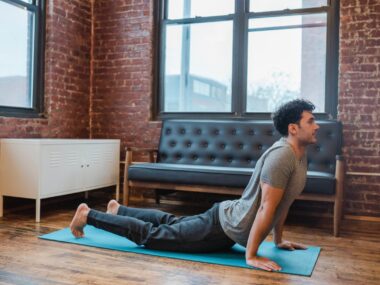In today’s fast-paced work environment, staying active can be a challenge, especially for those with desk jobs. Prolonged sitting has been linked to numerous health issues, including obesity, cardiovascular disease, and even decreased productivity. As the weekend approaches, it’s essential to find ways to incorporate physical activity into your workday to maintain your health and well-being. This is where “deskercise” comes into play—simple exercises and stretches that you can do right at your desk to stay active and energized. This comprehensive guide will explore various deskercise routines, their benefits, and tips for integrating them into your daily work routine.

The Importance of Staying Active at Work
Health Benefits
- Improves Posture: Regular deskercises can help counteract the negative effects of prolonged sitting, such as poor posture and back pain.
- Boosts Circulation: Moving regularly helps improve blood flow, reducing the risk of blood clots and varicose veins.
- Enhances Mental Health: Physical activity releases endorphins, which can improve mood and reduce stress and anxiety.
- Increases Energy Levels: Short bursts of exercise can combat fatigue and help you feel more energized and alert.
- Aids Weight Management: Incorporating movement into your day helps burn calories and can contribute to weight management.
Productivity Benefits
- Enhances Concentration: Regular movement breaks can improve focus and cognitive function.
- Reduces Stress: Physical activity is a proven stress-reliever, helping you stay calm and productive.
- Boosts Creativity: Taking a break to move can spark creativity and improve problem-solving skills.
- Improves Job Satisfaction: Feeling good physically and mentally can lead to higher job satisfaction and overall well-being.
Deskercise Routines
Stretching Exercises
- Neck Stretches
- How to Do It: Sit up straight, slowly tilt your head toward your shoulder, hold for 15-30 seconds, and repeat on the other side.
- Benefits: Relieves tension in the neck and shoulders.
- Shoulder Shrugs
- How to Do It: Raise your shoulders towards your ears, hold for a few seconds, then relax. Repeat 10-15 times.
- Benefits: Eases shoulder tension and improves posture.
- Seated Forward Bend
- How to Do It: Sit on the edge of your chair, feet flat on the floor. Reach forward and try to touch your toes, holding the stretch for 15-30 seconds.
- Benefits: Stretches the back and hamstrings.
- Wrist and Finger Stretches
- How to Do It: Extend your arm in front, palm up. Use your other hand to gently pull back on your fingers, holding for 15-30 seconds. Repeat with the other hand.
- Benefits: Reduces the risk of carpal tunnel syndrome and relieves wrist tension.
Strengthening Exercises
- Chair Squats
- How to Do It: Stand in front of your chair, lower yourself as if sitting down, but stop just before you touch the chair, then stand back up. Repeat 10-15 times.
- Benefits: Strengthens the legs and glutes.
- Seated Leg Lifts
- How to Do It: Sit up straight, lift one leg straight out in front of you, hold for a few seconds, then lower it. Repeat 10-15 times per leg.
- Benefits: Strengthens the core and leg muscles.
- Desk Push-Ups
- How to Do It: Place your hands on the edge of your desk, walk your feet back to create an incline, and perform push-ups. Aim for 10-15 repetitions.
- Benefits: Strengthens the chest, shoulders, and arms.
- Seated Marches
- How to Do It: Sit up straight, lift one knee towards your chest, lower it, then lift the other knee. March in place for 1-2 minutes.
- Benefits: Engages the core and improves hip mobility.
Cardiovascular Exercises
- Desk Jogs
- How to Do It: Jog in place behind your desk, lifting your knees high and pumping your arms. Aim for 1-2 minutes.
- Benefits: Boosts heart rate and energy levels.
- Invisible Jump Rope
- How to Do It: Pretend to jump rope, mimicking the motion with your hands and feet. Continue for 1-2 minutes.
- Benefits: Increases cardiovascular endurance and coordination.
- Seated Jacks
- How to Do It: Sit on the edge of your chair, perform jumping jacks by moving your legs out to the sides and raising your arms overhead, then return to the starting position. Repeat for 1-2 minutes.
- Benefits: Provides a full-body workout while staying seated.
Flexibility and Balance Exercises
- Seated Torso Twist
- How to Do It: Sit up straight, place your right hand on the back of your chair and twist your torso to the right, holding for 15-30 seconds. Repeat on the other side.
- Benefits: Improves spinal flexibility and posture.
- Ankle Circles
- How to Do It: Extend one leg and rotate your ankle in a circular motion, first clockwise, then counterclockwise. Repeat 10-15 times per ankle.
- Benefits: Enhances ankle mobility and reduces stiffness.
- Calf Raises
- How to Do It: Stand behind your chair, hold onto the back for support, and rise up onto your toes, then lower back down. Repeat 10-15 times.
- Benefits: Strengthens the calves and improves balance.
Tips for Integrating Deskercise into Your Workday
Set Reminders
- Use Technology: Set alarms or reminders on your phone or computer to prompt you to take a break and move every hour.
- Dedicated Apps: There are many apps designed to remind you to stretch and exercise throughout the day.
Make It a Routine
- Morning Start: Begin your day with a few desk stretches to wake up your body.
- Mid-Morning and Afternoon Breaks: Incorporate short exercise breaks into your mid-morning and afternoon routines.
- Post-Lunch Activity: Use deskercise to combat the post-lunch slump and re-energize yourself for the afternoon.
Encourage Colleagues
- Group Exercises: Encourage your coworkers to join you in deskercise routines. It can be a fun and social way to stay active.
- Deskercise Challenges: Create a challenge or competition to motivate everyone to participate regularly.
Adapt to Your Workspace
- Desk and Chair Positioning: Ensure your desk and chair are ergonomically positioned to support good posture and movement.
- Use Available Space: Utilize the space around your desk for standing exercises and stretches.
Stay Consistent
- Start Small: Begin with a few exercises and gradually increase the variety and intensity.
- Track Progress: Keep a log of your deskercise activities to stay motivated and monitor your progress.
- Be Mindful: Listen to your body and modify exercises if you experience discomfort.
Conclusion
Deskercise is a practical and effective way to stay active and healthy in a sedentary work environment. By incorporating simple exercises and stretches into your daily routine, you can improve your physical and mental well-being, boost productivity, and reduce the risk of health issues associated with prolonged sitting. As the weekend approaches, these small bursts of activity can keep you energized and ready to enjoy your time off. So, start integrating deskercise into your workday and experience the positive impact it can have on your overall health and workplace performance.










